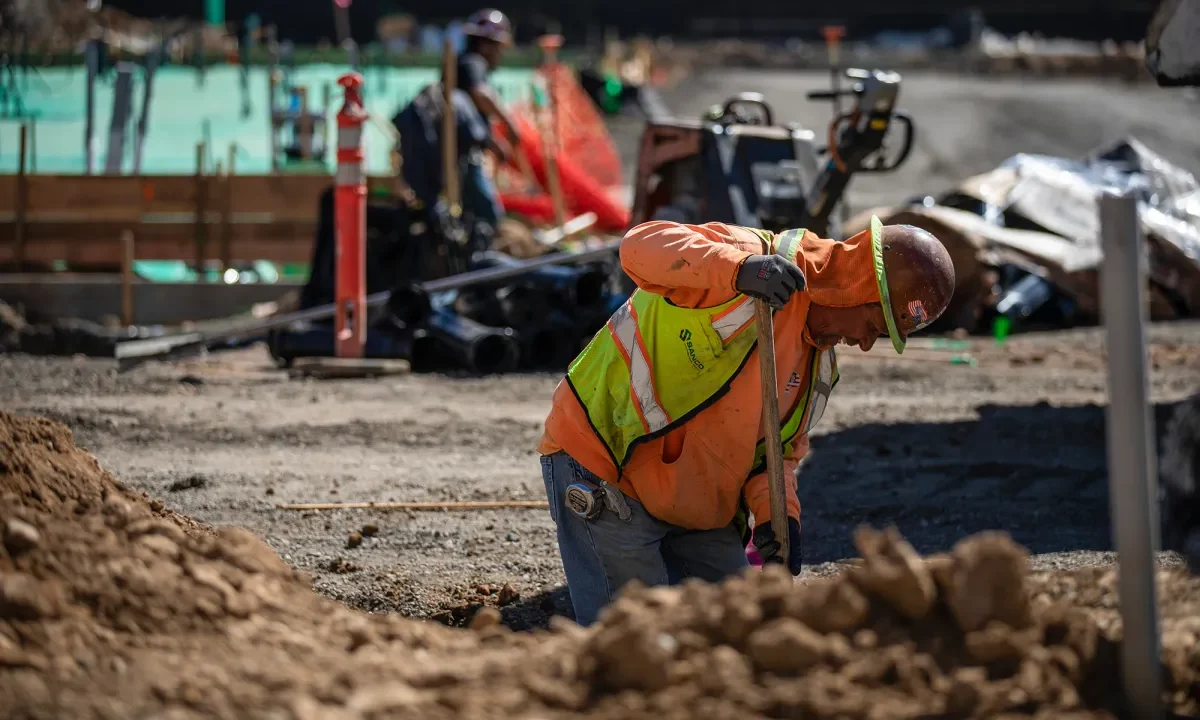Construction crews work in Saratoga, April 13, 2023. Lawmakers passed a bill to compensate workers harmed by heat. (CalMatters/Martin do Nascimento)

- High temperatures, sometimes in triple digits, afflict inland California workers in summer. This is a political issue with life-and-death consequences.
- AB 1336, now awaiting Gov. Newsom’s signature or veto, is the latest skirmish in a decades-long conflict over protecting workers from heat.
- Last year, the governor vetoed an almost identical measure, Senate Bill 1299.
Share
|
Getting your Trinity Audio player ready...
|
This commentary was originally published by CalMatters. Sign up for their newsletters.
In political jargon, “heat” means pressure on politicians to do something they may be reluctant, for whatever reason, to do.
But heat itself — high temperatures, sometimes in triple digits, that afflict inland California each summer — is a political issue with life-and-death consequences.
Assembly Bill 1336, now awaiting Gov. Gavin Newsom’s signature or veto, is the latest skirmish in a decades-long conflict over protecting workers from heat effects on their health, whether they work outdoors or inside.
The measure, if approved, would create a new legal presumption — that workers suffering from heat illness or injury would be entitled to workers’ compensation benefits if their employers failed to comply with standards set up to protect employees from heat effects.
What Will Newsom Decide?
Newsom’s signature on the bill is not a foregone conclusion. Last year, he vetoed an almost identical measure, Senate Bill 1299, saying, “There is no doubt that climate change is causing an increase in extreme temperatures and that California farmworkers need strong protections from the risk of heat-related illness. However, the creation of a heat-illness presumption in the workers’ compensation system is not an effective way to accomplish this goal.”
Twenty years ago, California saw a spate of heat-related deaths among farmworkers, leading former Gov. Arnold Schwarzenegger’s administration to adopt rules requiring employers to provide clean drinking water, adequate shade and paid breaks for outdoor workers during periods of high heat.
However the United Farmworkers Union has contended that staff shortages and lackadaisical management prevent the state Division of Occupational Safety and Health, better known as Cal/OSHA, from effectively enforcing those rules, leading to workers’ debilitating conditions and even death.
The union’s position was bolstered by a sharply worded report issued in July by state Auditor Grant Parks, laying out the agency’s shortcomings, particularly its shortage of adequate staff.
Bill Backers Want Employers to Follow the Rules
Backers of the two bills say not only are they seeking aid for heat-disabled workers, they also hope making employer-paid compensation more available spurs organizations to follow the state’s heat rules.
Meanwhile Cal/OSHA last year promulgated a new set of rules regarding heat in indoor workplaces, such as warehouses. They would require actions similar to those affecting outdoor workers when indoor temperatures hit 82 degrees.
As the issue of workplace heat simmers in California and other states, some federal agencies are pondering adopting heat-related protections for their employees. And a new study by the Massachusetts-based Workers Compensation Research Institute concluded that California’s pioneering regulations have had a dramatic effect on heat-related injuries and illnesses.
Previous research by the institute found that “excessive heat not only causes heat-related illnesses such as heat exhaustion but also impairs judgment and perception, increasing the risk of accidents, such as being struck by machinery. Heat-related illnesses are 11 to 18 times more frequent on days above 95°F, compared to days between 75 and 80°F, yet they represent 20 to 25 percent of all injuries attributable to heat.”
Heat-Related Injuries Now on the Decline
The study found California’s rules have reduced heat-related injuries by 15-17% in construction, 24-27% in agriculture and 19-25% in transportation. The strongest impact was when temperatures soared over 95 degrees, and the greatest effect was on young workers.
“These findings offer measurable evidence of how California’s policy reduced injury rates during extreme heat and offer relevant data to inform the national conversation about worker protection,” Ramona Tanabe, president of the research bureau, said in a statement with the report.
Still, agricultural and business groups have opposed both heat-related compensation bills. They say the workers’ compensation system isn’t equipped to make determinations about employers’ compliance with Cal/OSHA rules.
But if employers don’t like this approach to the issue, then they should be willing to do whatever is necessary to shore up Cal/OSHA. After all, protecting workers from high heat improves not only their lives but employers’ interests in maintaining productivity. It shouldn’t be a political football.
This article was originally published on CalMatters and was republished under the Creative Commons Attribution-NonCommercial-NoDerivatives license.



















